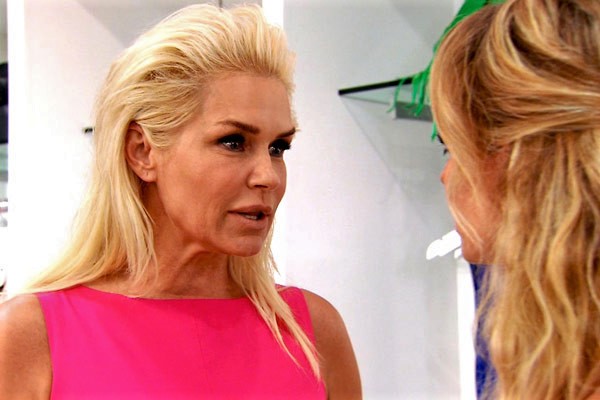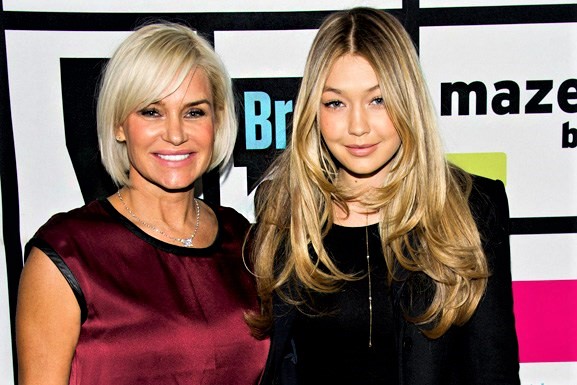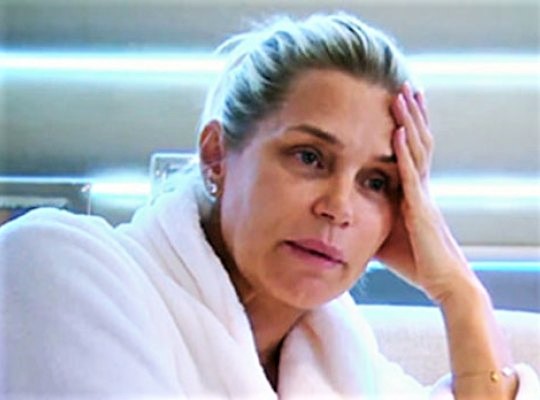Book Review: “Believe Me” by Yolanda Hadid
NY Post cost estimate:
http://nypost.com/2017/09/11/yolanda-hadid-made-her-own-poop-lab-to-treat-her-lyme-disease/


Yolanda before getting sick, with her children in Montecito. Photo credit: Yolanda Hadid, Instagram.
1964-2006
Yolanda van den Herik was born and grew up in a small town in the Netherlands. Her father died in an accident when she was young, and she and her brother were raised by their mother and their grandparents.
At age 13, she acquired a severe case of Epstein-Barr virus and was in bed for six weeks. Shortly after that, she lost her appendix.
She fell in love with the activity of riding horses in her early teens and began modeling primarily as a way to pay for expenses associated with horseback riding as well as to help to support her family. She soon became very successful as a model and eventually moved to the United States.
She was very athletic and for the most part had the energy to pursue a fast-paced modeling career. However, she sporadically had periods of time where she would experience unexplained fatigue and other health problems, and she also reported always being fairly intolerant of alcohol.
Later in life, her mother was diagnosed with breast cancer, uterine cancer, and Lyme disease.
Yolanda married her first husband – wealthy real-estate developer Mohamed Hadid – in 1994. They had three children (Gigi, Bella and Anwar), and then divorced in 2000.
After separating from her husband, Yolanda and her three children moved to Montecito, a small town near Santa Barbara, California. Yolanda said that the town felt comfortable to her and that it seemed that it would be a good place to raise a family.
In about 2002, Yolanda purchased a small farmhouse overlooking horse pastures, where she and the children went riding on a daily basis.
She reported the period of time from 2002 to late 2006 as being very busy and hectic but also very satisfying, and did not bring up any health issues experienced during this time.
Comments:
I have heard on numerous occasions of people getting sick with mononucleosis (caused by a new infection with Epstein-Barr virus) and appearing to eventually get well, but then developing ME-type illness later in life.
Why exactly that would be is unclear. However, since some people who are entirely EBV-negative nonetheless acquire ME-type illness, and since very large numbers of people who do have EBV in residence do not ever get sick with ME, it does seem fairly certain that EBV should not be considered the cause of ME (though it is possible that it might be an exacerbation factor).
I tend to think that the connection between mononucleosis and ME is that acquiring EBV only results in an active illness in people who already are immunocompromised, such as from a chronic mold exposure.
If it indeed is the case that many young people who become sick with mononucleosis have had chronic mold exposures, then it makes some sense to me that the toxic exposure might result in particular susceptibility to future toxic exposures (including toxic mold exposures), since there is only so much toxic exposure that people’s bodies can accommodate successfully before collapsing.
The fact that Yolanda’s mother later was diagnosed as having Lyme disease makes me further suspect that Yolanda might have been exposed to toxic mold in her home as a child.
If indeed experiencing an extended bout of mononucleosis as a child constitutes a risk factor for getting M.E., and if indeed toxic mold exposures as an adult constitute a further risk factor, then it would be useful for people to know this since then those people who are most at risk could take special measures to avoid the environmental exposures that might make them sick. Research into this topic therefore would be useful.
Based on how healthy and happy Yolanda and her children seemed to be when living in Montecito, I feel fairly confident that at least at this particular point in time, both the location and the buildings where they were living were pretty good ones from a toxicity standpoint.
2006-2010
In late 2006, Yolanda began dating David Foster, a successful record producer living in Malibu. He was very busy with his career and so Yolanda continued to spend most of her time with her children and the horses in Montecito.
In 2007, Yolanda began to experience frequent coughing as well as thyroid problems. A thyroid operation went poorly and most of her thyroid ended up being removed, and so she began taking prescription thyroid medicine.
In 2008, she decided to build a large house on the beach in Malibu with the plan of living there with David Foster and the children when it was finished. The property was completed in December 2010.
While the house was being built, she experienced frequent headaches and severe fatigue – both new symptoms for her.
She tried to cope by using IV Vitamin C and B12 injections, but her health continued to present more and more difficulties.
Comments:
2011
Yolanda and her children finished moving into the new house in Malibu in early 2011. She began planning for a wedding for the end of the year, as her health continued to decline.
She reported that her migraines became much more severe during this time period, lasting for three or four days at a time. Her brain fog (including difficulties with speaking as well as with memory) also continued to get worse.
She also started to have severe hair loss and “strange puffy half-circles” under her eyes.
In addition, during this time, she experienced mild Bell’s palsy like symptoms, where her facial muscles seemed to droop on one side.
“I feel like something is eating my brain,” she wrote.
By mid-2011, it had been about a year since really bothersome health issues had first appeared. Her symptoms would periodically recede and then return again, for unknown reasons.
Yolanda’s health problems got worse as the year went on. By fall, she noticed that her handwriting had declined dramatically. She had problems remembering what she read and paying attention to details.
She also started to experience problems with word recall, joint pain, cramps in her fingers and toes, exhaustion, insomnia, anxiety and exercise intolerance. Sound and light sensitivities also started to be a problem.
Conventional doctors prescribed Adderall and antidepressants, but they were not helpful.
Holistic doctors diagnosed her with food intolerances and heavy metal toxicity.
Yolanda and David Foster were married in November 2011. By then, he had moved his studio into the lower level of the house and was living in the home.
2012
By the beginning of 2012, Yolanda’s condition had become a “roller coaster of good and bad days.”
During this time, she was experiencing worsening memory problems; was losing the ability to be social; and was finding herself without enough energy to attend her children’s events.
Also during this time, her daughter Bella (who was about age 15) acquired mononucleosis. She went from being an outgoing and energetic child to a quiet and anxious teenager with a variety of intense symptoms (including severe spinal pain, fatigue and difficulty focusing), Yolanda wrote.
Yolanda insisted (over the objections of both her husband and her ex-husband) that Bella be home schooled for the rest of the year.
Despite her illness, Bella continued to enjoy spending time with horses.
At about this time, in mid-2012, Yolanda agreed to join the cast of “The Real Housewives of Beverly Hills” and began participating in the show.
On a trip to Naples, Italy, Yolanda decided to experiment with eating bread and desserts (which she had been carefully avoiding back in the U.S.). She got very sick as a result.
At this point, her fatigue was so severe that it was hard for her to walk from her bed to the bathroom. She also experienced very painful migraines, night sweats, fevers, severe brain fog, racing heart, and severe sound and light sensitivities.
She also had fluctuating eyesight problems, with black floaters or blurriness on some days.
Yolanda spent 12 days in Cedars-Sinai (a Los Angeles hospital) in order to try to get insight into her illness during this time. She wrote that she was completely debilitated and could barely sit up to be examined.
Cognitive testing revealed a number of focal deficits, including the inability to recall a set of random nouns (apple, nickel and calculator) for a short period of time; the inability to spell words backwards; and difficulties doing mental subtraction.
A brain scan showed swelling in the left frontal lobe of the brain, but doctors did not express much concern about this. Doctors also told her that she was negative for Lyme disease.
Tests did reveal elevated IgG levels for both EBV and hepatitis B.
Yolanda was sent home from the hospital with a diagnosis of chronic fatigue syndrome.
“This is BS. How many times do I need to tell the doctors that there is an infection in my brain?” she wrote. “I’m not a doctor, but I put a lot of effort into being health-conscious and savvy. I know that chronic fatigue is not a disease but rather an umbrella of underlying causes, a term doctors use when they don’t know what’s wrong with you.”
Yolanda decided to go to Belgium to see chronic fatigue syndrome specialist Dr. Kenny de Meirleir (combining the trip with a brief visit to see her family in the Netherlands).
After less than an hour into the flight to Belgium, she began to feel very sick.
“The altitude and rising pressure of the cabin causes some sort of inflammatory reaction in my brain, and I can feel a bad migraine coming on,” she wrote. “The pain quickly becomes intense and my eyesight becomes blurry.”
She then broke out into a high fever and began to cough loudly.
“What’s going on with my body?” she wrote. “Do chronic fatigue patients have fevers like this? Do their brains blow up like balloons?”
After arriving at her hotel in Belgium, she immediately took off her clothes and sat on the shower floor, letting the hot water run over the top of her head.
Dr. de Meirleir told her that he would not be sure what diagnosis to give her until results of lab testing were obtained in several weeks.
When Yolanda returned to her home in the U.S., she headed immediately to the shower. “The hot running water on the crown of my head cleanses me energetically,” she wrote.
She said that her beautiful house was “starting to feel like a jail.”
During this time, Yolanda fell for no particular reason in the bathroom, with the resulting cut on her head requiring 12 stitches.
She noted that by this point she had many food allergies and high heavy metal levels in her blood. Vitamins did not help with any of her problems, she wrote.
Dr. de Meirleir finally got back with her and informed her that she did not, in his opinion, have chronic fatigue syndrome. Rather, he said, she had “severe, chronic neurological Lyme disease.”
He recommended a 90-day course of IV antibiotics along with additional oral antibiotics.
He also diagnosed her with chlamydia pneumoniae, which she concluded may have been responsible for her chronic cough.
She began to see Dr. Steven Harris, a Lyme specialist, and got an IV port put into her arm in December 2012.
Yolanda noted that Dr. Harris had treated her husband, David Foster, for Lyme disease a few years earlier. David had made a good recovery after a short period of treatment, she said.
Comments:
2013
At the start of the new year, Yolanda began to get daily infusions of IV antibiotics.
She wrote that she became extremely sick as a result, with pounding migraines, frequent vomiting, low blood pressure, severely low white blood cell counts, and severe yeast infections.
“It’s like having the worst case of the flu times ten, being hit by a truck, being run over by a train, and ending up in the washing machine on the spin cycle,” she recalled.
Because she was so sick, she again spent some time in the hospital but then was sent home.
“Many nights thereafter, I lie on my bathroom floor, shivering from head to toe, as if demons have taken over my body,” she wrote. “I desperately need to ground myself on Mother Earth so sometimes at night, when I’m home alone, I go outside to my backyard in my underwear with my warm blanket to lie on the grass, where I can hear the waves crash on the shores and stare at the stars and the moon.”
She concluded, “Interestingly the antibiotics that I THOUGHT would be the answers to my prayers are actually making me so sick that I feel as if I am going to die.”
At this point, Yolanda’s friend Suzanne Somers suggested that she travel to Florida to see Dr. Rick Sponaugle, who focuses on treatment of Lyme disease and mold illness. Yolanda and her good friend Paige (who also had chronic Lyme disease) decided to travel there for a few months to obtain treatment.
The clinic is located in Palm Harbor, Florida (near Tampa-St. Petersburg).
Dr. Sponaugle used a variety of IV’s – including some to kill pathogens and others to detoxify debris from dead pathogens – as well as ozone, colonics, coffee enemas, chiropractic treatments, supplements, and many other therapies on Yolanda.
Yolanda commented that she believed that the colonics were especially helpful since she had suffered from constipation since childhood.
After a few weeks living in a hotel room, Yolanda and her friend decided to move into an apartment so that they could cook for themselves.
“Dr. Sponaugle points out that I have high levels of mold in my body,” she wrote. “This is a big problem for people with Lyme because it weakens the immune system. Therefore, any apartment we rent has to be tested for mold before we can move in.”
Yolanda reported feeling somewhat better after three weeks at the clinic. Her lab tests also showed improvements.
“I feel well enough to push myself to walk on the beach every night at sunset,” she wrote. “I become obsessed with it, squeezing out every last drop of my physical energy to stroll on the sand and clear my mind at the end of each day.”
Halfway through the treatment, Yolanda flew to Phoenix to meet her husband for a few days for an event. She suffered a relapse on the trip, attributing the symptoms to exhaustion from the activity.
After spending some additional time at the Sponaugle clinic, Yolanda was found to be positive for Lyme on conventional tests. She attributed this to the spirochetes having been driven out of hiding into the bloodstream by the treatments.
She left the Sponaugle clinic feeling more energetic and with fewer severe symptoms in general. She stated that she looked at her illness differently after spending time there.
“It is more clear that I am not only fighting Lyme but also the co-infections – parasites, viral and bacterial infections, mold exposure, and heavy metals – and most likely have a long road of healing in front of me,” she wrote.
After only a few weeks of being back at home, Yolanda relapsed. She reported that a big collapse came after spending the day at the girls’ horse show one Saturday.
“I get home feeling achy and fatigued, and my chronic cough comes back,” she said. “The next morning, I wake up with rings under my eyes again, which I have learned is a measure of inflammation in my brain.”
Looking back at her experiences with the Sponaugle clinic, Yolanda wrote that she believed she did better when she was in Florida because she was focusing all of her efforts on treatments and did not have any other stresses or obligations in her life.
Once she was back at home, she realized that she was nowhere near cured and was just trying to hang on, she wrote.
Also during 2013, Yolanda’s 14-year-old son Anwar – who had suffered from joint pain, exhaustion and sinus infections for several years – was diagnosed with chronic Lyme. He decided that he would prefer to try to treat his illness holistically than to go through the sorts of treatments that his mother had pursued.
Toward the end of the year, Yolanda concluded that her body felt like a toxic waste dump and that she was afraid to discuss the very expensive treatments that she had tried publicly because she did not want other people to waste their money on them.
2014
In early 2014, Yolanda became concerned about her daughter Gigi, who was living in New York City while going to school and working as a model.
“One day when we Face Time, it’s the middle of a dark and extremely cold winter day in New York City, and Gigi is not herself,” Yolanda wrote. “She’s crying over little things that usually would not bother her, and even though she has a fever and has been ill with what I think is a flu and exhaustion, something doesn’t feel right.”
Yolanda spent six weeks early in the year visiting the Paracelsus Clinic in Switzerland, which was run by Dr. Thomas Rau. The doctor used darkfield analysis and told her that he believed that the Lyme had attacked her optic nerve.
Yolanda adopted the clinic’s “autoimmune diet” (including organic vegetables, fruit, rice, and grass-fed meat). The doctors at the clinic encouraged her to stop getting Botox treatments; to stop using laxatives; to switch to a glandular form of thyroid supplementation; and to address dental issues (including metal-based crowns, root canals and cavitations). They also focused on her body pH.
Yolanda tried a number of therapies while in Switzerland, including IV ozone; a hyperthermia treatment that raised her body temperature to 103 degrees (with the goal of killing pathogens); a 48-hour liver cleanse; colonics; and other therapies focused on detoxification, the immune system, and the digestive tract.
“We sleep with the windows wide open because I love the smell of the fresh mountain air and the soul-soothing sounds of nature and silence without any traffic noise,” she recalled.
After the clinic stay, Yolanda’s husband encouraged her to travel with him to stay in the nearby home of some friends. Yolanda spent almost the entire visit in bed, however.
She returned home with thousands of dollars in supplements in her suitcases.
Yolanda reported that as was the case with her previous therapies, the trip to Switzerland had seemed to lower her levels of inflammation and give her more strength while she was away, but that the improvements did not last after she returned home.
Both her body and her brain were in general continuing to decline rapidly at this time, she said.
After an MRI showed inactivity in the left frontal lobe of her brain, Yolanda decided to try transcranial magnetic stimulation (TMS) therapy. After about six weeks, her brain function seemed a little better, but the improvements didn’t last and were not anywhere near a cure, she stated.
Yolanda next tried a protocol involving taking 150 supplement pills per day, designed by a man named Richard Helfrich. The protocol cost thousands of dollars per month and was, Yolanda said, “probably the most hideous protocol of the whole journey.”
However, the protocol did help her health more than anything else she had thus far tried, she wrote.
“After five months, I have more strength, can function a little better, and have slightly more energy,” she recalled. “Instead of being in bed all the time, I’m in bed three days and up for one. On a good day, I push myself to walk down the driveway, although this lands me back in bed the next day. That said, it hasn’t cured my Lyme yet or given me back my old life.”
Test results suggest that her health (especially her liver function and hormones) improved while on the Helfrich protocol. Thyroid function, white blood cell count and CD57 remained problematic, however.
A highlight of the year came when Yolanda visited Bali on vacation. She felt good there and thoroughly enjoyed a national day of silence that occurred during her trip.
Yolanda then went to Tijuana, where she obtained an embryonic stem cell treatment from Dr. William Rader. Ultimately she concluded that it was “another expensive disappointment,” however.
Initially, the stem cells made her feel less inflamed and stronger, and her chronic cough went away, she reported. However, the improvements only lasted for a few weeks, and laboratory tests did not show much improvement.
Yolanda tried a few more naturopathic treatments, including Rife therapy, during this time but did not experience any substantial improvements as a result.
Also this year, Yolanda’s daughter Bella experienced a bad crash while riding on her horse. The accident was attributed by a Lyme doctor to neurological Lyme and antibiotics were prescribed, but the die-off response was so severe that the drugs were stopped.
Yolanda’s son, Anwar, tried low-dose immunotherapy (LDI) and subsequently got very sick with a 102-degree fever.
By November, Yolanda was feeling worse than ever and convinced her husband that they should put the Malibu beach house on the market.
“Not only do I feel trapped in my brain, I also feel trapped in this big, beautiful house,” she wrote. “I no longer see its beauty, all I see is pressure.”
Because Yolanda felt better in small spaces, she moved – along with her husband and her son Anwar – to David’s condo in Beverly Hills.
Also toward the end of the year, Yolanda consulted with chronic Lyme specialist Richard Horowitz, M.D.
She reported that Dr. Horowitz said to her, “You’re not just fighting Lyme and co-infections, like babesia with possible exposure to Q fever, another tick-borne infection, but you also have evidence of heavy metals and mold toxins, with detoxification problems, nutritional deficiencies, mitochondrial dysfunction, multiple hormone abnormalities, chronic insomnia, an imbalance in the part of your body that controls your blood pressure called the autonomic nervous system, as well as your being deconditioned….There also is the problem of persister cells and biofilms. These are cells that are resistant to the long-term antibiotics that you have taken.”
Dr. Horowitz prescribed a protocol of antiparasitical medications. Yolanda started the protocol a few days before Thanksgiving and experienced a severe Herxheimer reaction within about a week.
During the first week of December, Yolanda traveled to Santa Barbara to see a screening of the movie “Selma.” However, she got sick enough that she was forced to walk out of the movie and then the related dinner.
She flew to New York to attend an event but ended up in the hospital (receiving pain medication and IV fluids) in Santa Monica immediately upon her return to California.
She spent Christmas with extended family at the Malibu house, then traveled to Miami to stay with her husband on a business trip in a hotel room overlooking the ocean. She became very sick during this trip, experiencing a severe chronic cough, severe anxiety, shivering, and fevers.
On one occasion on the beach at night, she removed all her clothes and headed into the sea.
She found that smoking raw tobacco on the balcony was helpful to her during this time. She brought up the idea that Native Americans once used tobacco to address parasites and wondered if it might be helping her in the same way.
On December 31, 2014, Yolanda wrote in her journal, “I’ve lost my life. Worst New Year’s ever.”
2015
In January 2015, Yolanda and her children Bella and Anwar flew to Korean to get stem cell infusions. Yolanda felt very sick while in Korea and said that like other treatments she had tried, the stem cells gave her a temporary lift in energy but without any noticeable long-term improvements. Her children did not receive any extended benefits either.
“I consider the trips to Korea a big waste of time and money,” she wrote. “I’m worse than in all the years I’ve been sick.”
Also during early 2015, Yolanda used a variety of different treatments, including Biltricide and other antiparasitical medications, ozone, colonics, coffee enemas, Epsom salt baths, lymphatic drainage massage, and Xanax.
She reported having done a total of 80 hyperbaric treatments, concluding that they always seemed to make her symptoms worse without any subsequent improvements.
“I feel there’s a demon inside me, some monster that has taken over my gut,” she wrote. “At one in the morning, I wake up with severe night sweats. I go out on the balcony in my underwear and lie down because the cool stone against my skin is the only relief that I can find.”
In February, Yolanda noticed a large parasite come out of her body when doing a colonic. Following that, she expelled large numbers of additional parasites but did not feel much better as a result.
At about this time, Yolanda hired a full-time health advocate. This individual suggested seeing Dr. Dietrich Klinghardt, an integrative physician located near Seattle.
Dr. Klinghardt told Yolanda that parasites were just part of the bigger picture for her. He stated that she also needed to get a tonsillectomy and to work on dental issues.
It would take her two years following his recommendations to get better, Dr. Klinghardt told her.
Dr. Klinghardt then treated her with neural therapy injections in the scars in her back, as well as injecting DMPS in her jaw to remove heavy metals. The treatments resulted in swelling and pain at the sites of the injections.
Yolanda continued to work on parasite issues, following a protocol using a series of natural enemas (with ingredients such as milk, salt, baking soda, mint, sea buckthorn, eucalyptus and messmate leaf) from a Russian practitioner named Gubarev.
She concluded that some of the parasites had been living in her intestines for many years.
In April 2015, Yolanda traveled back to Tijuana to get an ozone treatment with Dr. Louie Yu. She says that blood came out of her body looking almost black, then was returned to her body looking bright red after being treated with ozone.
She reported feeling a little better when driving back to L.A. after the treatment, but then much worse after getting back home.
During this time, she continued to pass more parasites and said that she believed that parasites were affecting her eyesight.
“At this point, it’s probably not the Lyme that’s keeping me down, but the worms,” she wrote. “I feel like my body has been invaded by some crazy creatures. They just keep coming out. I have pieces of flesh coming out of me, something is eating my insides that nobody is seeing.”
A scan of her small and large intestines using a capsule camera showed nothing unremarkable, her doctors informed her.
However, a full-body scan showed a rupture in her silicone breast implants. Yolanda recalled that she had breast-fed her children while she had the breast implants and wondered if this may have impacted their health.
Yolanda traveled to the Bahamas to get a very expensive adipose stem cell procedure, where fat was removed from her thighs and then injected back into her body.
“Although the clinic and the Bahamas are beautiful, the hotel is hot, musty and filled with mold, which I’m severely allergic to,” she wrote. “We sleep with all the windows open, just to keep the fresh air coming through.”
She spent as much time as possible on the trip lying on the beach in her bathing suit, rather than in the room.
After the procedure was completed, she woke up in the hotel room to find that she was lying in a pool of blood as a result of the incisions on her legs starting to bleed. The bottom half of her body remained black-and-blue for an extended period of time after returning to the U.S.
Despite the difficulties with this treatment, Yolanda felt that her health improved somewhat as a result. She wrote that her body seemed less inflamed, that her skin looked better, that she was coughing less, and that her hair stopped falling out.
She then had nine metal-based crowns plus an infected tooth removed from her mouth.
She followed the dental work with a pleasant 10-day boat trip through British Columbia with her husband.
In late summer, Yolanda had an operation at the Cleveland Clinic to remove her silicone breast implants. The operation was a very difficult one because the implants had leaked and material had spread throughout her chest cavity.
She experienced a large amount of pain after the surgery, but also noticed that her chronic cough disappeared entirely.
Yolanda recovered from the surgery at the Santa Barbara beach house of a friend. She used cryotherapy, neural therapy, Myers’ cocktails, a mini-trampoline and other detoxification treatments to attempt to heal.
Following the silicone “explant” surgery, Yolanda noticed that she had big sores on top of her head and that some of her toenails had turned black. She attributed this to leftover silicone granulomas being pushed out of her body.
She also gained 20 pounds during this time.
Dr. Kent Holtorf switched her thyroid medication to compounded T3 and T4.
The Malibu house finally sold, with the buyers expressing the desire to keep all the furniture. Yolanda agreed to this because she was solely focused on her health, she wrote.
“The buyers can keep it all, even my closet and my clothes!” Yolanda stated. “At this point I need simplicity and the thought of being free from this stress is worth everything.”
In November 2015, David Foster moved out of the condominium and stated that he wanted a divorce. Yolanda looked for her own condominium in the Beverly Hills area and found one that she felt particularly good about.
“We step into a very calm, open space,” she recalled. “It’s as if God is watching over me and leading the way. This is where I’m meant to live. The space is really bright and feels strangely safe…. Energetically this feels like the right place for me, as if I am meant to be here.”
Not having any furniture from previous homes (even a bed to sleep on) meant that Yolanda was starting over from scratch in terms of her possessions.
She moved into the condominium at the beginning of December and was bothered somewhat by chemical and EMF sensitivities.
In going through boxes from previous residences, in many cases she decided that it would be better if those things stayed in storage.
“Many of the items I unpack bring back memories,” she says. “Some of them are painful so I put them right back into the box to be dealt with at a later date. I realize how much stuff I’ve accumulated over time and how little of it means anything to me. I truly have no attachment to material things other than the photo albums of my children’s lives.”
She and her children spent Christmas in Aspen with friends and had a good time.
2016
Yolanda resumed using the last name of Hadid in 2016, because it was the one that her children were using.
She continued to pursue a variety of therapies early in the year, including Dr. Klinghardt’s natural Lyme protocol (with Sporanox for fungal infections), ionic footbaths, neurotherapy, IVIG, IV vitamin C, and ozone.
She also used CBD oil for pain and inflammation; started a new anti-inflammatory diet with a variety of organic produce, beans, nuts and seeds; and underwent “family constellation therapy.”
She said that she felt better during this time if she ate very little. She spent most of her time at home because being in social settings invariably caused her to start to get sick and to experience a shutdown in brain function.
Yolanda had more dental surgery, including the removal of six root canals and the addressing of cavitations in her jawbone. The surgery took eight hours and the pain during the recovery was intense.
After the operation, Yolanda and a friend traveled to Tahiti for a vacation.
“I throw a few bathing suits in a suitcase and make my way to the airport,” she wrote. “This trip to paradise at a charming little beach hotel with people I love turns out to be one of my best vacations ever. There is a profound shift inside of me, and I truly believe it’s the beginning of a new chapter. It’s crucial for me to be close to nature and connected to the earth, so I spend every day soaking in the gorgeous warm Tahitian waters with a big hat on my head. After a couple of days I actually feel like gently stretching my arms in the water. I haven’t moved my body like this in what seems like years, so it feels incredible….Outside of the comfort zone of my cocoon, I can actually see the light at the end of the tunnel and finally experience the feeling of joy.”
While in Tahiti, Yolanda engaged in an Ayahuasca ceremony, which involves drinking a dark brown tea made from a rainforest vine called Caapi. This was followed by a shot of Kambo, made from frog venom. Yolanda experienced vomiting (including of some “black tarry stuff”) and diarrhea as a result of these treatments, but then felt better afterward, she said.
The Tahiti trip was enjoyable enough that Yolanda decided to take another trip to Tahiti later that summer. She spent as much time as possible in the water or walking on the white-sand beach, she wrote.
At about this time, Yolanda decided not to sign on for another season of “Real Housewives.”
Later in the year, Yolanda followed Dr. Klinghardt’s advice and had her tonsils removed. Two of her children, Bella and Anwar, had previously undergone the surgery and found it helpful, and Yolanda stated that she felt that it turned out to be a good thing for her as well.
She also had a dead tooth removed from her mouth and replaced with a metal-free implant.
Yolanda continued to engage in a variety of other treatments focused mostly on detoxification, including salt baths, ionic foot baths, colonics, coffee enemas, glutathione drips, IV ozone, IVIG, cell peptides, heparin shots, and a 10-day “Master Cleanse.”
The use of a “Bemer” device was intended to open up the vascular system and keep blood flow moving.
In order to balance hormone levels, she received estrogen and testosterone pellets four times a year.
In addition, she and her health advocate made their own low-dose immunotherapy (LDI) using Yolanda’s own urine, stool, tonsils and other material, following Dr. Klinghardt’s instructions.
Also at the suggestion of Dr. Klinghardt, she underwent TVAM (transvascular autonomic modulation) surgery. She felt worse for a few weeks after the surgery – supposedly because the pathogens that lived in the vascular system were forced to evacuate. After a few months had gone by, Yolanda concluded that the surgery had brought down her overall inflammation levels in a more long-term way.
Yolanda traveled to London in September 2016 and then started making plans to move to New York City, where all three of her children were working as models.
She stated that her colon was continuing to release problematic debris and that her brain function was improving during this time.
By the end of the year, Yolanda stated that she was feeling considerably better and that lab tests suggested that her immune functioning was continuing to improve.
However, she said that her DNA Lyme test was still positive and that she wondered if complete eradication of Lyme was even a possibility.
2017
Although the book only covers the period of time up until early 2017, Yolanda’s health has continued to improve since that time, she has said in interviews.
“I feel amazing,” she told Access Hollywood in September 2017. “Finally, I’m out on the other side.”
In the interview, Yolanda recounted on how she came to define her illness as Lyme disease. “I was ill for maybe a year and eventually I ended up with a diagnosis of chronic fatigue, which didn’t resonate with me,” she said. “And I went to Belgium and got diagnosed by a Lyme specialist there, and that’s when my journey really started.”












